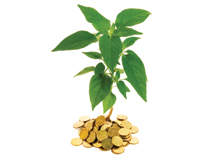
There is no doubt that a brand can benefit from a greener image, as consumers become increasingly mindful of the environmental implications of their purchasing decisions. This perception still colours the approach many companies take to sustainability, with the result that changes are often cosmetic and do not reflect fundamental corporate values. Yet, for those companies that have invested the time and effort to put it at the heart of their business plan, the benefits go far beyond
greenwashing a brand.
For some leading product companies, environmental issues have become an important influence on the strategic decision-making process affecting packaging, product design and marketing strategies.
"Sustainability is consistent with our mission of 'nourishing lives', which includes doing the right things for communities and for the future. We are working to improve the health profile of our products and at the same time improve our environmental footprint," says Paul Earl-Torniainen, senior packaging engineer for General Mills.
With a diverse range of highly successful products and a large volume of sales, General Mills, the company behind Betty Crocker, Häagen-Dazs, Pillsbury, Green Giant, Old El Paso and Cheerios, has the capacity to invest in new technologies and the scale to see how efforts to improve sustainability impact the business. Packaging is a key target for improving the company's environmental performance and it constantly monitors its performance, but Earl-Torniainen is keen to stress that the goals of the green agenda are of value only if they are balanced with commercial reality.
"We see sustainability as part of our business strategy among other factors that we must consider in packaging, namely performance and cost. All three factors are very important, but we have a wide variety of consumers so our packaging decisions depend on their expectations. A key challenge now is to identify ways to create packaging with a smaller environmental footprint without compromising on cost," he believes.
Are consumers going green?

US Tariffs are shifting - will you react or anticipate?
Don’t let policy changes catch you off guard. Stay proactive with real-time data and expert analysis.
By GlobalDataAs consumers become more informed about the concept of sustainability there are signs that they are changing their purchasing behaviour to some extent, but Earl-Torniainen feels that it has not yet become the defining factor.
"It very much depends on the consumer. For some, sustainability has been a key part of purchasing decisions for years, but they were relatively few.
“Now, however, we are close to tipping point. European consumers in particular are more aware than US consumers, and attitudes vary greatly between different geographies."
Consumers are likely to consider the environmental impact of their purchasing decisions more and more, but for now they are still more likely to pick a product on price. For a company like General Mills, therefore, the drive for greener packaging must not come at too high a price.
Nevertheless, he believes that the industry has a duty to look at sustainability as a long-term issue and would like to see more companies investing in research and development with a view to the commercial, social and environmental benefits that will accrue further down the line.
A platform for sustainability
The way forward, Earl-Torniainen believes, is to invest in the development of new technologies and materials which will define sustainable packaging solutions in the years ahead.
He also notes, however, that a company does not have to wait until the conclusion of the development process to benefit from a strategy influenced by environmental concerns. In fact, the low-hanging fruit should incentivise companies to reach much higher.
"We have research groups that look many years down the road. They look at technology in terms of its performance, which includes sustainability among the criteria, and what will drive the biggest transformation. There are some quick wins, mostly associated with issues like waste," says Earl-Torniainen.
For now, these quick wins are not enough to encourage some companies to invest. Many still fear that sustainability programmes will be too expensive and do not feel sufficiently convinced of the long-term returns. For Earl-Torniainen, the choice is clear – the scale of returns in the future will depend on the level of investment and commitment that a company makes now.
Working together for the future
Earl-Torniainen stresses the importance of not only making the right external partnerships to tap into the latest thinking on sustainable packaging materials and technology, but also creating the right internal networks to bring together all parts of the company where decisions are made that affect any aspect of packaging, including its environmental impact.
At General Mills, for example, Earl-Torniainen leads the sustainable packaging effort but does not work in isolation. He is part of a network of people throughout the organisation who share information and share the responsibility.
"We connect people from the very top to the very bottom of the company. People work on sustainability as part of their daily jobs. A coordinated approach means people understand what the best practices are, and the company as a whole can learn from what individual business units do well," he explains.
Whatever investment a company makes in improving the environmental performance of its packaging, Earl-Torniainen is keen to stress that the first step is the most important.
Before pursuing specific projects, a company should put sustainability at the heart of its strategic thinking, where it can sit alongside commercial considerations and help to define clear targets for both short-term and long-term gains.
"The mission of nourishing lives doesn't change. If you have done a good job of setting the mission then the goals stay the same even though products and packaging are modified in line with customers" expectations," he says.
The engagement of large companies like General Mills is pushing forward the sustainability agenda and its packaging strategy has clearly shown that environmental considerations can be successfully balanced with cost. Its experience suggests that companies should not tinker on the edges of the green agenda, but should grasp the nettle.



